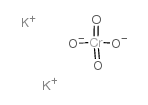Potassium chromate

Potassium chromate structure
|
Common Name | Potassium chromate | ||
|---|---|---|---|---|
| CAS Number | 7789-00-6 | Molecular Weight | 194.19000 | |
| Density | 1.00 g/mL at 20 °C | Boiling Point | N/A | |
| Molecular Formula | CrK2O4 | Melting Point | 971 °C(lit.) | |
| MSDS | Chinese USA | Flash Point | N/A | |
| Symbol |



GHS06, GHS08, GHS09 |
Signal Word | Danger | |
|
DNA double-strand breaks by Cr(VI) are targeted to euchromatin and cause ATR-dependent phosphorylation of histone H2AX and its ubiquitination.
Toxicol. Sci. 143(1) , 54-63, (2014) Hexavalent chromium is a human respiratory carcinogen that undergoes intracellular activation in vivo primarily via reduction with ascorbate. Replication of Cr-adducted DNA triggers mismatch repair that generates toxic DNA double-strand breaks (DSBs) as secon... |
|
|
Disrupting monotony during social isolation stress prevents early development of anxiety and depression like traits in male rats.
BMC Neurosci. 16 , 2, (2015) Although there have been several reports on social isolation induced mood alterations, the independent contribution of monotonous environment in mediating mood alterations has been less studied. In view of the above, the present study is aimed at investigatin... |
|
|
Long-Term Provision of Environmental Resources Alters Behavior but not Physiology or Neuroanatomy of Male and Female BALB/c and C57BL/6 Mice.
J. Am. Assoc. Lab. Anim. Sci. 54 , 718-30, (2015) Few studies have evaluated the long-term effects of providing environmental resources to mice. This consideration is important given that mice are often maintained in vivaria for months. We evaluated the effects of providing simple cage resources (wood wool, ... |
|
|
Bioremediation of hexavalent chromium (VI) by a soil-borne bacterium, Enterobacter cloacae B2-DHA.
J. Environ. Sci. Health. A. Tox. Hazard. Subst. Environ. Eng. 50 , 1136-47, (2015) Chromium and chromium containing compounds are discharged into the nature as waste from anthropogenic activities, such as industries, agriculture, forest farming, mining and metallurgy. Continued disposal of these compounds to the environment leads to develop... |
|
|
Multi-element distribution profile in Sprague-Dawley rats: Effects of intratracheal instillation of Cr(VI) and Zn intervention
Toxicol. Lett. 226(2) , 198-205, (2014) • We studied how Cr(VI) exposure individually affected the element distribution in target organs and tissues. • The more susceptible tissues like RBC were found, which would contribute to the future studying of early sensitive health impact of Cr(VI). • This ... |
|
|
Baicalin inhibits free radicals processes initiated by chromium ions.
Acta Pol. Pharm. 67(6) , 706-9, (2010)
|
|
|
Effect of hexavalent chromium on histone biotinylation in human bronchial epithelial cells.
Toxicol. Lett. 228(3) , 241-7, (2014) Chromium is a potent human mutagen and carcinogen. The capability of chromium to cause cancers has been known for more than a century, and numerous epidemiological studies have been performed to determine its carcinogenicity. In the post-genome era, cancer ha... |
|
|
Three-dimensional digital microfluidic manipulation of droplets in oil medium.
Sci. Rep. 5 , 10685, (2015) We here develop a three-dimensional DMF (3D DMF) platform with patterned electrodes submerged in an oil medium to provide fundamental solutions to the technical limitations of 2D DMF platforms and water-air systems. 3D droplet manipulation on patterned electr... |
|
|
Saccharomyces cerevisiae: the effect of different forms and concentrations of iodine on uptake and yeast growth.
FEMS Yeast Res. 9(1) , 45-51, (2009) The essentiality of iodine for humans, especially in the early stages of life, is well recognized. The chemical forms of iodine in food supplements, infant formulae and iodated salt are either iodide (KI) or iodate (KIO(3)). Because there are no or rare data ... |
|
|
Elucidation of the percutaneous absorption of chromium compounds by functional proteomics.
Proteomics 9(22) , 5120-31, (2009) Chromium compounds are known to be associated with cytotoxicity and carcinogenicity when applied via a skin route. The aim of this study was to evaluate the skin permeability and toxicological profiles of four chromium species. Chromium permeation across the ... |